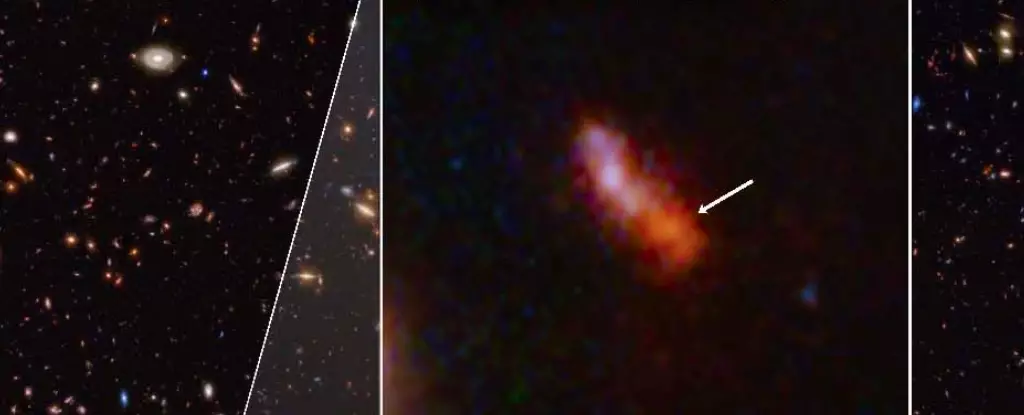The James Webb Space Telescope (JWST) has once again astounded the astronomical community with its latest revelation. This groundbreaking space observatory has pushed the boundaries of our understanding of the Universe’s infancy by detecting light from a galaxy, designated as MoM-z14, that formed just 280 million years after the Big Bang. This remarkable finding represents the most distant galaxy yet observed, shattering previous records held by more modest telescopes like the Hubble Space Telescope and Spitzer Space Telescope.
Before the advent of JWST, the limitations imposed by smaller mirrors hampered our ability to explore the early Universe in infrared wavelengths. The Hubble’s 2.4-meter mirror provided some insights into near-infrared light, yet it managed to identify only one galaxy from the first 500 million years. Meanwhile, Spitzer’s 85 cm mirror, despite its specialization in infrared observation, could hardly compete. With JWST’s expansive mirror and cutting-edge detector technology, astronomers are now delving into the depths of time, systematically uncovering galaxies that illuminate the history of cosmic evolution.
Unveiling the Assembly of Galaxies
One of the core scientific pursuits of JWST is the Assembly of Galaxies, which aims to understand how galaxies form and evolve in the early Universe. Since its operational debut, JWST has discovered an unexpectedly plentiful array of luminous galaxies at redshifts exceeding 10. The detection of MoM-z14 is pivotal as it expands our observational boundary closer to the dawn of cosmic history.
Researchers behind a new paper titled “A Cosmic Miracle: A Remarkably Luminous Galaxy at Zspec = 14.44 Confirmed with JWST,” led by MIT’s Rohan Naidu, emphasize how this revelation has electrified the field, prompting renewed inquiries into the mechanisms of galaxy formation during the first few hundred million years. The discovery underscores an abundance of bright galaxies in the early Universe, challenging prior assumptions that expected few such celestial bodies at this high redshift.
A Peek into Early Cosmic Chemistry
The spectroscopic analysis of MoM-z14 has unveiled intriguing details about its composition. Unlike many distant galaxies which have active galactic nuclei powered by supermassive black holes, light measurements suggest that the majority of this galaxy’s brightness emanates from its stars. This hints at the presence of luminous supermassive stars, predicted to exist in the early Universe, thus validating theoretical models.
Moreover, the unusual nitrogen-to-carbon ratio found in MoM-z14 hints at complex chemical processes underlying its formation. Its chemical fingerprints bear a resemblance to ancient globular clusters associated with the Milky Way, suggesting that the star formation processes in such early clusters mirror those we observe today. This perspective is fascinating, as it implies that ancient star formation and evolution might follow patterns we can now trace across billions of years.
New Insights into Morphological Diversity
The distinctive morphologies of early bright galaxies present another layer of intrigue. Researchers suggest that the ancient galaxies tend to fall into two categories: compact point sources and more extended forms. These morphological variations could signify deeper connections between a galaxy’s form and its evolutionary pathway.
The authors note a burgeoning class of early galaxies that exhibit significant nitrogen emissions, including a newly identified subgroup called luminous Little Red Dots. MoM-z14, in particular, could stand as one of the most notable nitrogen-enhanced entities detected by JWST. This finding hints at a possible size-chemistry relationship that could reveal substantial insights into the conditions and processes prevalent in the high-redshift Universe.
The Broader Implications for Astronomy
The scientific community has ardently awaited the JWST’s discoveries, and its capability to peer into the early epochs of the cosmos has been nothing short of revolutionary. While the findings have often surprised astronomers, they have also illuminated connections between these revelations and our current Universe.
By exploring these ancient galaxies and their characteristics, astronomers are constructing a narrative that spans the entirety of cosmic history. Researchers emphasize that the chemical characteristics of MoM-z14, along with their correlation to ancient stars in the Milky Way, provide critical insights into how galaxies have evolved and formed over vast expanses of time.
As we look forward, the anticipation builds for the future capabilities of the Roman Space Telescope, which is expected to unveil hundreds more galaxies of this nature. A larger pool of data will not only reinforce current hypotheses but may also divulge new cosmic mysteries waiting to be unraveled.
With the JWST leading the charge, a new chapter in our understanding of the Universe is unfolding, where the boundaries of observation are continuously being pushed, revealing the remarkable complexity of early galactic life. The tools available to astronomers today fuel a hope that understanding of the Universe’s early periods will no longer remain distant, but become increasingly tangible, shaping our comprehension of what lies beyond the observable limits.


Leave a Reply